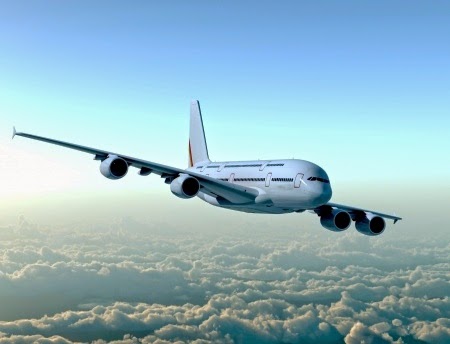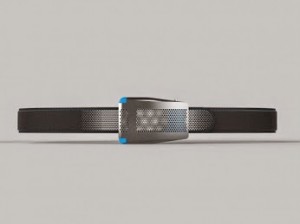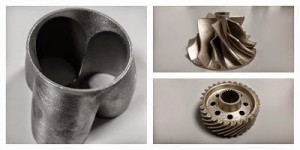 |
| Aerospace is one of the main industries that can benefit from developments in 3D Printing |
The aerospace industry is a main market for additive manufacturing. This is not only because this sector has a long history of an early adopter of latest technology inventions, but also because it needs these inventions. Environmental performance restrictions, competitive market conditions and high manufacturing cost are just some of the challenges that aerospace faces today. And this is exactly where the benefits of additive manufacturing come to the fore: shorter production time, no required additional tooling, material savings and cost-efficiency are just some of the good reasons why aerospace companies should integrate 3D printing in their production strategies.
DMLS (direct metal laser sintering), also called selective laser melting or selective laser sintering is the mostly used 3D prienting technique for production of aerospace components.
The main benefits of metal 3D printing for the aerospace industry can be summarized as follow:
- Complex designs
Additive manufacturing offers unbelievable flexibility in terms of geometry and it enables shapes not previously possible to be manufactured. This creates more space for innovation and exploration of new designs.
- Weight reduction
Weight reduction is one of the biggest issues in aerospace manufacturing. Lighter aircraft components have double impact on the industry. On the one hand less weight leads to lower fuel consumption and CO2 emissions and on the other hand means less cost and better airfares.
- Improved strength and durability
The mechanical properties of metal powders as Inconel 718 and titanium Ti6Al4V lead to improved strength and exceptional resistance in high temperatures and corrosive conditions, encountered in aircraft engines.
- Major savings
3D printed parts create less waste compare to traditionally manufactured ones which leads to environmentally friendly and energy efficient vehicles. The excellent mechanical properties of Inconel 718 and Titanium Ti6Al4V have led to their diverse use in the aerospace additive manufacturing.
Inconel 718
This is a nickel-based superalloy, containing chromium (Cr), molybdenum (Mo) and niobium (No). Niobium acts with molybdenum and improves tensile, rupture and creep strength without heat treatment. Its main advantage is keeping its strength at high temperatures by building a stable oxide layer that protects the surface. Inconel 718 shows best mechanical and chemical properties in temperature ranges from cryogenic up to 700 oC (1300 oF). The metal is also corrosion and oxidation resistant, in particular to sulphide chloride and sulphide corrosion cracking and aqueous corrosion, all typically performed in jet engines. The weldability and machinability of Inconel 718 is another appealing characteristic of the metal for additive manufacturers. It possesses high resistance to post-weld age cracking and can be welded in either the annealed or precipitation (age) hardened condition.
Titanium Ti6Al4V
The main characteristic of titanium Ti6Al4V, also known as TA6V or Ti64 is its strength, low weight ratio. 3D printed titanium possesses also excellent resistance to fatigue, crack, corrosion and creep. Precipitation hardening including solution annealing, quenching and age hardening contributes to increased yield, bearing and shear strength. When considering low cutting speeds, high feed rate, large quantities of cutting fluid, sharp tools, rigid setup the metal can be also easily machined. Besides its wide use in aerospace and aeronautics applications, 3d printed titanium Ti6Al4V is preferred also for the production of biomedical implants because of its biocompatibility.
The following aerospace components are subject to extreme temperatures and corrosion. The mechanical characteristics of 3D printed Inconel 718 and titanium Ti6Al4V deliver excellent resistance and make them most suitable metals for the manufacture of:
- Low and high temperature fasteners
- Discs, hubs, spacers, seals
- Compressor blades
- Structural parts
- Complex turbine engine components
- Blisks
- Cases, rings
- Exhaust parts
Additive manufacturing provides the aerospace sector with grate benefits. This is a revolutionary technology that possesses the full potential to solve all sector?s issues by meeting the global demand for safe, convenient and reliable air transportation. The use of additive manufacturing and in particular direct metal laser sintering will grow and develop over the next decades.
Find out How is 3d Printing Effecting Other Industries
 |
| 3D- Printing Luxury Goods |
Ralitsa Peycheva is a technical content writer, interested in forging and casting techniques, latest machinery and tools; curious about new manufacturing methods; respecting high-quality engineering; discovering, observing and admiring the additive manufacturing industry. Follow her on Google + https://plus.google.com/u/0/+RalitsaPeycheva/posts


Nice article.
HI
I want to know which 3D printer is best for aerosapce industry?
Thanks
Ali
Hi I need to know how to make turbo charger compressor wheel